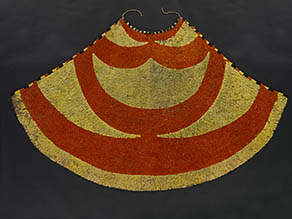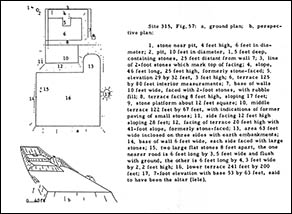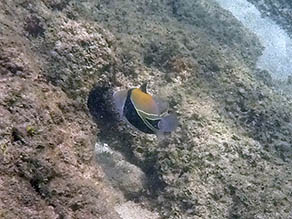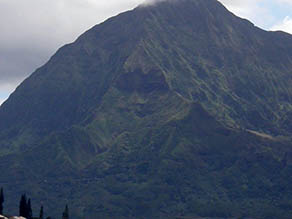| |||||||||||||||||||||||||||||||||||||||
 |
“Puna and Hema were surfers,” Ian tells us. “Kaha‘i's father Hema was the younger one, Hema Puna was the older and they asked their mom Hina-hānai-a ka-mālama, who worked in the moon, if they could go surf. And she said ‘I get ukus [lice], can you guys pick some head lice out of my hair?’ Puna, the elder, goes ‘Naah Mom, I’m going to go surf the waters of my father’—that is, choose a wife from his own line to keep the blood pure, keep the ranks high. Hema goes ‘Ok Mom, I’ll pick the ukus out of your hair.’ And she said ‘Good boy, you know you get your priorities straight: family first and then surf and all.’ "But her point was ‘You respect that kapu of women. I want you to go down to my high ranking lineage in Tahiti and go get this wahine named Hua-uri out of Vai-te-marama from this pool. She’s an underworld sea goddess, you got to grab her by the hair and drag her past forty houses to show that she’s yours, and make her yours.’
“In this Tahitian version of the story, he does so and then she becomes pregnant. In the Hawaiian version of the story, same thing happens: he brings up here, she becomes pregnant and before the child is born she tells him ‘Hey Hema, you got to go back down and get the ahu‘ula, the ring feathered circlet, the feather cloak that that will show the symbol of my family’s rank. "Because guess what? Because of my high ranks and the wife that you chose from Tahiti close to the source, the ranks of your children will be raised to that equal to those of Puna’s children.’ Because that’s the way when two high lineages meet. They create a high crest, like where two waves meet, the two crests create a high peak. In that metaphor is absolutely all the oceanography of Hawaiian knowledge. “So Hema goes across the great sea, down to get the birth right for this child to be born that became known as Kaha‘i. And Hema goes across the great sea to the place called Motutapu, and he is challenged by the great bird, the ‘Ā‘aia bird, the a‘a (or the ‘ai‘ai, some say), and had his eyes gouged out and thrown in the pit of filth. And in this chant, the pit of filth is Ulupa‘upa‘u. And I’m reading this thing going, ‘Those are the place names of my place, Ko‘olau.'
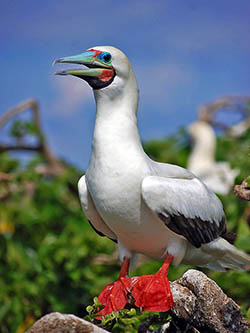
Dennis writes, “If mana was somehow held captive in a distant place, it had to be retrieved. On his voyage to Kahiki to get his son’s birth-gift, Hema was captured by some fishermen, and his eyes were gouged out to be used as fish-bait (Thrum, More Hawaiian Folk Tales 71). A chant records that Hema was ‘seized by the ‘ā ‘aia bird’ (a legendary bird in the form of the ‘a , or booby; figuratively Hema ‘went crazy’; or the ‘ā ‘aia could be a symbolic reference to fishermen or a god of fishermen, as this seabird fishes in the open ocean and was a guide to finding fish.) “Hema’s eyes were said to be at ‘Ulupa‘upa‘u, in Kahiki, where Kaha‘i went to retrieve them, treading the “ke ko‘i‘ula a Hema,” “the rainbow-hued trail of Hema” (Kamakau Tales 142). Eyes were an embodiment of mana, or more specifically knowledge, ‘ike, which was based on both literal and figurative “seeing.” Pukui points out that one form of ritualized cannibalism to gain mana was to scoop out and eat the eyes of an enemy (Nānā i ke Kumu 151). “Kaha‘i went to retrieve his father Hema’s mana; at the same time he revealed his own mana through a successful voyage which is celebrated in chant (Kamakau Tales 142):
“Variants of the stories of Hema, Kaha‘i, Wahieloa, and Laka have been recorded throughout Polynesia in Tahiti, Tuamotu, Aotearoa (New Zealand), Rarotonga, Aitutaki, and Mangaia (Cook Islands), the Marquesas, Vaitupu (Ellice Islands), Pukapuka, Sāmoa, Tonga, and the Santa Cruz Islands (Beckwith, Hawaiian Mythology 259-275). These stories of four generations of chiefs either originated in Hawai‘i and spread elsewhere; or perhaps were brought to Hawai‘i by voyaging chiefs from the South Pacific and localized by Hawaiian genealogists. 
“In the Tahitian tradition, Kaha‘i, or Tafa‘i, as he is known there, was a great voyager who “fished up” (i.e. discovered) Hawai‘i, a fact which is remembered in the phrase “the fish-line of Kaha‘i” in a chant by Kamahualele, the foster son of Mō‘īkeha, another famous voyaging chief of Hawai‘i (Beckwith Hawaiian Mythology 355). That the story of the Hema family is so widespread in Polynesia suggests the importance of its theme: the need for the ali‘i to remain connected to the mana of the homeland.” “I live in Hakipu‘u at the base of the mountains over there,” Ian says. “And there’s a very important heiau there called Puakea. That heiau was the sacred shrine of Lono and its still one of the most sacred sites on the O‘ ahu. All the knowledge is rooted and based over there. I have been going over there for about ten years to study the archeo-astronomy of that heiau, and it does turn out the corners are in line with the winter solstice sunrise to the summer solstice sunset, on diagonals. Across the center of it is the Piko o Wakea, the Equator line, the broad wide sky father. So I’ve been watching, and on the shortest day of the year—winter solstice—the sun rises like a fireball out of Ulupa‘u crater. Amazing! “He‘eia is the grandson of Haumea, bringing up yet another tradition. “At the time when he was born, there was a great flood or tsunami on the land. The story that’s related about that tsunami is the one that of Haumea and her husband Wākea. Kumuhonua was the chief that was battling Wākea. And they chase Wākea and Haumea’s forces up to Palikū, there in the cliff, and they climbed up the cliffs and threw kukui nuts at them. “And then while this happened, a great tsunami came in. And it washed them all out to sea. And while they were all out on the sea, they ask the kahuna that was with them, ‘What do we do? How do we survive this flood? Here we all are out on the sea.’ And the kahuna said ‘Well we have to make a heiau, a place of worship.’ ‘Oh, how do you that?’ He said ‘Cup your hands. Good. Now we to make our sacrifice and honor the deities. You must find a pig, a pua‘a.’ And the people ‘How we’re going to find a pua‘a on the sea?’ “Humuhumunukunukuapua‘a, our state fish. And so of course just like in Hollywood, as a matter of convenience, one swims by! They got a humu and they placed it inside the ‘heiau.’ It’s like the old ‘here is the church, here is the steeple, inside this is all the people.’ Make a place of worship, put the put the offering inside and then the kahuna prayed. "The floods receded, and they ended up there on Kapapa, that islet offshore there. Now Haumea and Papa are likely one and the same—if not the same family, then within their genealogy. I have my thoughts on that. Papa being earth mother, Wākea being a sky father. Anyway, they landed there on the islet and were saved. “Then the two of them were able to escape over the mountains behind in Kāne‘ohe side, the little gap there which was called Kilohana. They ran down Kalihi and the warriors caught up Wākea. Haumea wrapped around him, turned into the ‘ulu tree and they escaped inside the trunk of the ‘ulu tree.” Lilikalā provides deep background on the story of Haumea. The story of Wākea and Haumea is also discussed on the Nu‘uanu website. “You see the two eyes, the sphinx inside Konahuanui?” Ian points to the mountain. “The two dark spots are the eyes and then the triangle nose with the kind of the dark line right beneath it. Those are the eyes of Kāna the great god. On the ridge on this side the little bump is his heiau and he did the survey of the land. He was a stretching deity, the first priest of Kāne and he did a survey of all the lands to find out the census population and their water availability and the works of the people of this place. We see it really well there now when the sun comes on. Nāmakaokāna is what that site is called, the eyes of Kāna. He’s our deity, who’s always watching over us wherever you are in Kāne‘ohe and north. “He tried to reach out to Ka‘iwa, who was the Lanikai chiefess, but he was blocked by Olomana’s warrior, Pāku‘i and ‘Āhiki, which are the peaks of Olomana, just over the hill there.”
“When Ka‘ohelo was nearing death she said to her son, “Should I die, do not bury me at any other place, but take rny body to the very navel of your grandmother, right on top of Kilauea; then bury me there.” When Ka‘ohelo died her son took her dead body: that is the creeping part as well as the bush-plant part. The flesh became the creeping vine and the bones became the bush-plant. Pele retained Ka‘ohelo’s head, which became the smouldering fire’ in the volcano; the rest of the body was thrown over to Haleakala, Maui, and to salty Keai‘ia, O‘ahu; some of it was thrown on Kaua‘i, and some of it was left on Hawai‘i. 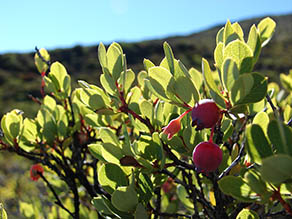
“When Malulani, living on Lāna‘i, heard of the death of their youngest sister, she came over to get her, thinking that Pele hadn’t kept her; when she arrived she did not find her whole body. It was scattered and lost over the ground, and it was sprouting and growing from the soil. She commenced to gather and bundle it, thinking that that was all, as she wanted to care for it. But some time after, as she went back: to Lanai, she saw Ka‘ohelo’s body strung and worn as leis by the people; and because she loved her youngest sister very much she hung herself.” Ka‘ohelo’s spirit travels along until she arrived in Ko‘olau, O‘ahu: “Heeia was a good-looking man of that time living there, but he had died. When his soul saw her soul they greeted each other as strangers’ do, and he took her to his home.” The two marry and have a daughter, Waialani, “a beautiful and a good woman, better even than her mother." Waialani travels to bring back the body of Malulani, and on Hawai‘i island encounters her aunts Pele and Hi‘iaka arguing. Pele tricks Waialani into eating some ‘ohelo berries, which are the body of Waialani’s mother. In anger, Waialani swears never to recognize Pele again until the grave. Then she and Hi‘iaka travel to Lāna‘i. “She went and got the corpse of Malulani, which was decomposed; they went back to her parents’ place, where they all wailed. Then they stayed there, the women, the husband and the daughter. After some days Waialani made up small bundles of the body of Malulani which she scattered outside of Heeia, a hill here and a hill there until the place held many hills which are standing even unto this day. And because of the Flood, all these hills were submerged, and appeared as islets, and that is why it is called the sharp coral of Heeia; and it is there even to the present time as most of you know who have been to the place.” |
 |
|||||||





